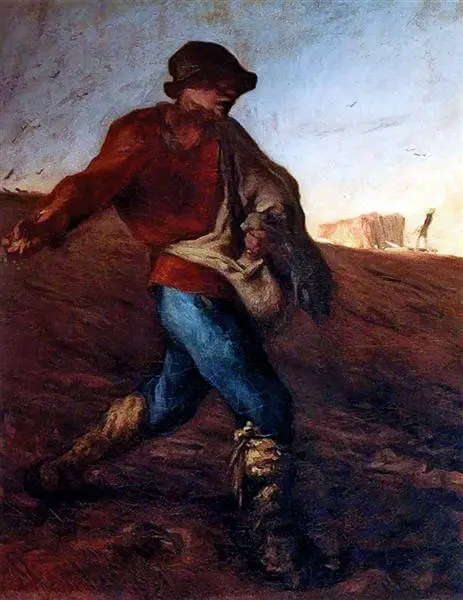Title of Artwork: “The Sower”

Artwork by Jean-Francois Millet
Year Created 1850
Summary of The Sower by Jean-Francois Millet
The Sower is an oil painting that was created in the year 1850 by the French artist Jean-Francois Millet. It shows a rural worker planting seeds in a field as the sun is setting. It is currently housed in the collection of the Museum of Fine Arts in Boston, which is located in Boston.
Millet’s personal and religious beliefs about the dignity and heroism of rural labour are depicted in the painting, which serves as an expression of those beliefs.
In addition to this, it reflects the political and social shifts that occurred in France after the revolution of 1848. One of the most well-known and influential of Millet’s works, “The Sower” was an inspiration to a great number of other artists, including Vincent van Gogh.
All About The Sower by Jean-Francois Millet
The Sower is Millet’s most well-known motif, and it was one that he explored repeatedly in his work between the years 1850 and 1870. The subject conveyed significant meaning for Millet, both on a personal and a spiritual level.
However, his initial rendition, which is now kept in the collection of the Museum of Fine Arts in Boston, caused a ruckus when it was exhibited at the Paris Salon in the year 1850. At a time when the situation of the French rural poor was deteriorating and socialism threatened bourgeois society, viewers were shocked by Millet’s heroic treatment of a lowly peasant.
The lithographic version of this painting can be found in the Metropolitan Museum of Art in New York City, while the later version of this painting can be found in the Carnegie Museum of Art in Pittsburgh.
Van Gogh held the greatest admiration for Millet as an artist. Van Gogh admired Millet’s other treatments of the theme, and he tried to emulate them. However, he was never able to see Millet’s famous painting, “The Sower,” because it was already in a collection in Boston when van Gogh was born.
The meaning of “The Sower” isn’t crystal clear because various critics and scholars have come up with their own unique interpretations of what it means. The following are some possible interpretations:
As the sower plants the seeds that will eventually develop into crops, this image serves as a metaphor for the continual cycle of life and the hope for the future.
A depiction of the parable of the sower from the Bible, in which Jesus compares the word of God to seeds that are sown on various types of soil.
A reflection of the social and political situation in France after the revolution of 1848, which granted universal male suffrage and recognised the rights of workers. In 1848, France had just gone through a major political upheaval.
An expression of admiration and respect on Millet’s part for the farmers and peasants who toiled away in difficult conditions to make a living.























